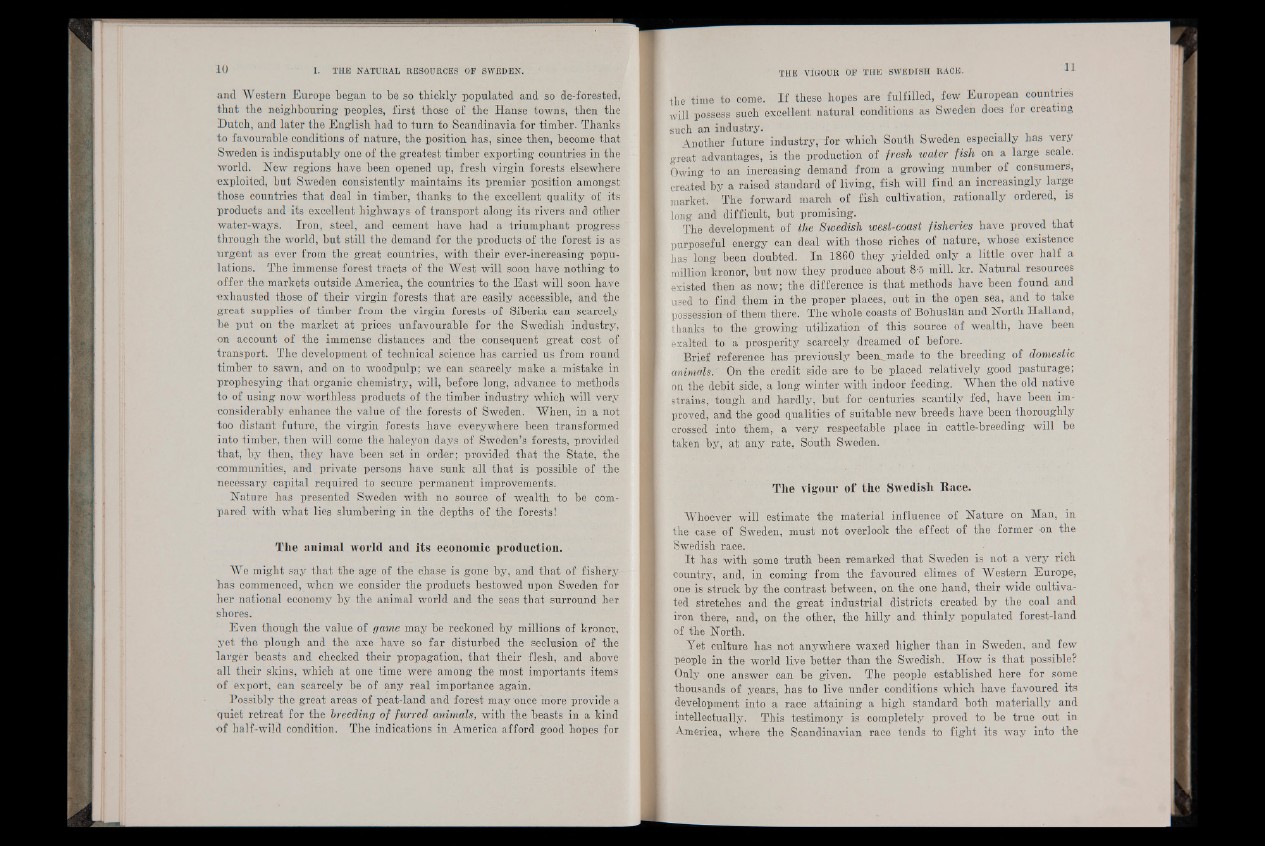
and Western Europe began to be so thickly populated and so de-forested,
that the neighbouring peoples, first those of the Hanse towns, then the
Dutch, and later the English had to turn to Scandinavia for timber. Thanks
to favourable conditions of nature, the position has, since then, become that
Sweden is indisputably one of the greatest timber exporting countries in the
world. New regions have been opened up, fresh virgin forests elsewhere
exploited, but Sweden consistently maintains its premier position amongst
those countries that deal in timber, thanks to the excellent quality of its
products and its excellent highways of transport along its rivers and other
water-ways. Iron, steel, and cement have had a triumphant progress
through the world, but still the demand for the products of the forest is as
urgent as ever from the great countries, with their ever-increasing populations.
The immense forest tracts of the West will soon have nothing to
offer the markets outside America, the countries to the East will soon have
exhausted those of their virgin forests that are easily accessible, and the
great supplies of timber from the virgin forests of Siberia can scarcely
be put on the market at prices unfavourable for the Swedish industry,
on account of the immense distances and the consequent great cost of
transport. The development of technical science has carried us from round
timber to sawn, and on to woodpulp; we can scarcely make a mistake in
prophesying that organic chemistry, will, before long, advance to methods
to of using now worthless products of the timber industry which will very
considerably enhance the value of the forests of Sweden. When, in a not
too distant future, the virgin forests have everywhere been transformed
into timber, then will come the halcyon days of Sweden’s forests, provided
that, by then, they have been set in order; provided that the State, the
communities, and. private persons have sunk all that is possible of the
necessary capital required to secure permanent improvements.
Nature has presented Sweden with no source of wealth to be compared
with what lies slumbering in the depths of the forests!
The animal world and its economic production.
We might say that the age of the chase is gone by, and that of fishery
has commenced, when we consider the products bestowed upon Sweden for
her national economy by the animal world and the seas that surround her
shores.
Even though the value of game may be reckoned by millions of kronor,
yet the plough and the axe have so far disturbed the seclusion of the
larger beasts and checked their propagation, that their flesh, and above
all their skins, which at one time were among the most importants items
of export, can scarcely be of any real importance again.
Possibly the great areas of peat-land and forest may once more provide a
quiet retreat for the breeding of furred animals, with the beasts in a kind
■of half-wild condition. The indications in America afford good hopes for
the time to come. I f these hopes are fulfilled, few European countries
will possess such excellent natural conditions as Sweden does for creating
such an industry. .
Another future industry, for which South Sweden especially has very
great advantages, is the production of fresh water fish on a large scale.
Owing to an increasing demand from a growing number of consumers,
created by a raised standard of living, fish will find an increasingly large
market. The forward march of fish cultivation, rationally ordered, is
long and difficult, but promising.
The development of the Swedish west-coast fisheries have proved that
purposeful energy can deal with those riches of nature, whose existence
has long been doubted. In 1860 they yielded only a little over half a
million kronor, but now they produce about 8-5 mill. kr. Natural resources
existed then as now; the difference is that methods have been found and
used to find them in the proper places, out in the open sea, and to take
possession of them there. The whole coasts of Bohuslan and North Halland,
thanks to the growing utilization of this source of wealth, have been
exalted to a prosperity scarcely dreamed of before.
Brief reference has previously been..made to the breeding of domestic
animals. On the credit side are to be placed relatively good pasturage;
on the debit side, a long winter with indoor feeding. When the old native
strain®, tough and hardly, but for centuries scantily fed, have been improved,
and the good qualities of suitable new breeds have been thoroughly
crossed into them, a very respectable place in cattle-breeding will be
taken by, at any rate, South Sweden.
The vigour of the Swedish Race.
Whoever will estimate the material influence of Nature on Man, in
the case of Sweden, must not overlook the effect of the former on the
Swedish race.
It has with some truth been remarked that Sweden is not a very rich
country, and, in coming from the favoured climes of Western Europe,
one is struck by the contrast between, on the one hand, their wide cultivated
stretches and the great industrial districts created by the coal and
iron there, and, on the other, the hilly and thinly populated forest-land
of the North.
Yet culture has not anywhere waxed higher than in Sweden, and few
people in the world live better than the Swedish. How is that possible?
Only one answer can be given. The people established here for some
thousands of years, has to live under conditions which have favoured its
development into a race attaining a high standard both materially and
intellectually. This testimony is completely proved to be true out in
America, where the Scandinavian race tends to fight its way into the